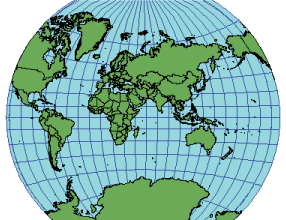Description
This projection is similar to the Mercator projection except that it portrays the world with a curved graticule. The overall effect is that area is distorted less than on a Mercator projection, and the shape is distorted less than on equal-area projections.
Learn about the Mercator projection

Projection method
The Van der Grinten I projection is a compromise projection and is not in one of the more traditional classifications.
Linear graticules
The equator and the central meridian of the projection.
Properties
Shape
Distortion increases from the equator to the poles.
Area
Minimal distortion along the equator and extreme distortion in the polar regions.
Direction
Local angles are correct only at the center.
Distance
Scale along the equator is correct.
Limitations
Can represent the world, but the most accurate representation is between the 75th parallels of latitude.
Uses and applications
Used for world maps—formerly one of the standard world map projection of the National Geographic Society.
Parameters
Desktop
- False Easting
- False Northing
- Central Meridian
Van der Grinten I Auxiliary Sphere (Desktop version 9.3 and later)
- False Easting
- False Northing
- Central Meridian
- Auxiliary Sphere Type
Workstation
- Radius of the sphere of reference
- Longitude of Central Meridian
- False Easting (meters)
- False Northing (meters)